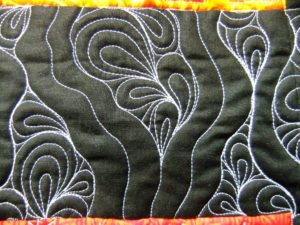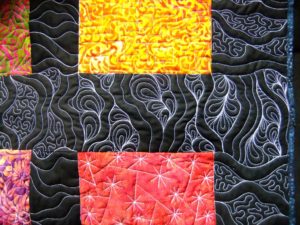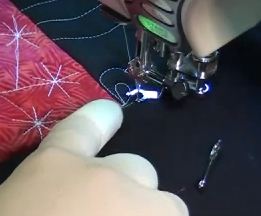Quilt Along #36: Quilting Trapped Paisley
It’s Quilt Along time! This month we’re stitching out many Edge to Edge Designs that will work perfectly in the sashing or borders of any quilt.
This week let’s try another variation of Flowing Lines and review Paisley at the same time by stitching the two designs together to form Trapped Paisley:

I think this has got to be my favorite edge to edge design of all time! I love how the dense Paisley stands out so boldly within each gap space. Let’s see how this design works on the Batik Beauty Quilt:
Difficulty Level – Intermediate.
Design Family – Edge to Edge.
Quilting this design works exactly like Goldilocks (flowing lines + stippling), only the addition of paisley adds a lot more thread texture and a bit more trickiness as this design is a bit more challenging to fit into the gap spaces.
However, you might be wondering about the quilting density – how tight the lines of quilting are and if this is going to make the surface of the quilt stiff and uncomfortable.
Feeling the surface of Batik Beauty, yes, this area does feel a bit stiffer, but it’s not to the point that this quilt will be so stiff it feels like cardboard to sleep under.

If you’re still really worried about it, make a sample! Use the fabric and batting you’re planning to use in a real quilt and first stitch a sample of Trapped Paisley to make sure it’s the design you want.
This sample will serve multiple purposes: give you more practice of the design, let you see and audition the texture and feel on your quilt before starting on it, and allow you to test the batting you’re considering to make sure it’s not going to do something funky in the middle.
So don’t take my word for it that Trapped Paisley will be open enough for your purposes. Make a small sample and see for yourself. It might just save you hours of seam ripping if the design just totally doesn’t work with your quilt.
Another tip shared in the video had to do with seam allowances.
When you piece any 2 fabrics together, you produce seam allowances on the back of your quilt top. Right now the most popular method is to press the seams to one side, usually to the side of darker fabric.
Take a minute to watch the video and listen to my machine as I quilt in the ditch, and especially when I’m quilting close to the corners of the blocks:

In these spaces, there are several layers of seam allowances in addition to the batting and backing fabric. If you close your eyes and listen, you’ll hear a louder POCK POCK noise when my needle drops into these areas.
Now here’s the interesting thing – all my seam allowances are pressed OPEN.
Even with open seam allowances (one allowance pushed to one side, the other to the opposite side), there is still a difference in the sound and reaction of my machine when quilting through these spaces.
Notice how I stitch off these spaces pretty quickly. When I hear my machine making a different noise, even one as subtle as a louder noise when the needle drops, it usually means that area is being tricky.
The fact is, you might not be able to SEE the seam allowances when you quilt, but your thread and needle will most definitely let you know when there are too many layers to comfortably stitch through.
The most common issue in these areas is your thread breaking because the extra layers of fabric are putting a bit extra strain on the needle and thread.
Yes, I do strongly encourage you to press your seam allowances open for this reason. For one thing, pressed open, your block will be more accurate. The lump created by 2 seam allowances pressed to one side will be flattened out, making your block more true to its intended size.
While quilting, you will be able to quilt right in the ditch and fill to either side without risking your foot being hung up by the thick lump of 2 seam allowances.
Now what if you have a pieced quilt top and all the seam allowances are already pressed to one side?
Don’t try to change it. Just quilt it the way it is, but pay attention to the areas you know several seam allowances are resting. Stitch through those areas carefully and mindfully. You might need to slow down considerably for your machine to handle the corners or points especially. When pressed to one side, those areas could have 4-6 extra layers of fabric all piled up on top of one another, and your machine will notice it!
If you have a particularly tricky area that you keep breaking thread over, use the hand wheel and manually stitch the few stitches to get through the area, then try to avoid stitching through it again.
Of course, there is a theory that by pressing the seam allowances open, then stitching in the ditch right on top of the piecing stitches, you will somehow weaken your quilt. The theory is your needle will pierce and rip open the piecing stitches holding your blocks together.
Personally I’ve never seen or heard of this happening. I believe stitching in the ditch right over the piecing stitches will, if anything, strengthen the quilt. More thread holding everything together is a good thing, not a bad thing!
I also think it might have something to do with quilters pressing seam allowances to one side and wanting an excuse to not stitch right in the ditch – because it’s nearly impossible when there’s a huge lump of seam allowances on one side and a valley on the other.
However, if you’re really worried about it just take some extra care with your piecing lines. I always piece with my stitch length at 1.5 mm, which produces very tight, even stitches that are almost impossible to rip out.
I figure if I can barely rip them out with even the tiniest seam ripper, how in the world can the needle pierce the stitches to rip them in the quilting?!
But as with many things in quilting, this is an opinion driven / biased motivated kind of thing. Go with what you feel is right for your quilts, but understand that the decisions you make in the piecing can come back to haunt you in the quilting.
Instructions for Linking Up Your Blog:
1. Write your blog post. Publish it on your blog.
2. Copy the link of the specific blog post. This is not just the link to your blog itself (www.freemotionquilting.blogspot.com), but the link to the specific post: https://freemotionproject.com/2012/01/quilt-along-2-quilting-in-rows.html
3. Click the blue link up button above and paste your link into the box.
Keep in mind that you’re posting your progress from LAST week on THIS week’s post. This way you have time to watch the lesson, play with the ideas, then post your progress to the next quilt along. I hope that makes sense!
Also it’s not required, but highly appreciated and super cool to link back the Free Motion Quilt Along so everyone you know can come quilt with us too.
Let’s go quilt!
Leah Day

I totally agree with you about pressing seams open for optimal quilting Leah. I recently quilted a quilt for a customer which had lots of HST and they were all pressed to one side… some of the corners were so bulky that my darning foot would get caught up on them and not want to move. On one particular corner my foot got stuck, it wouldn't move, and so I tugged to try to get it free and well- I ended up sewing right through my finger! The needle went through my nail bed, out the back and a chunk of it broke off inside my finger. It was very painful and I couldn't quilt for a week, though it took over a month for it to heal and the needle fragment to work it's way out. Not only can quilting pressed to one side seams be tough to do, it can also be dangerous!
Love the trapped paisley. Can't wait to try it out.
When you press seams open, do you use a regular size iron? I recently completed a rail fence top with lots of seams and decided to reduce bulk by pressing open. It was really a chore to get all those small seams pressed open. Any hints on how you accomplish this?
I haven't been around in quite some time, but this design caught my eye. I do love paisley! After errands, its FMQ practice. Looking forward…
Beautiful texture combining the Goldilocks with the trapped paisley. Thanks for sharing.
This is a beautiful design, and of the designs I've tried, is the one that comes most naturally to me. Thank you for sharing your progression in FMQ and your wonderfully informative tutorials. I always, always tell my quilting friends to "Google" you for inspired designs and instructive videos. Again, thank you!